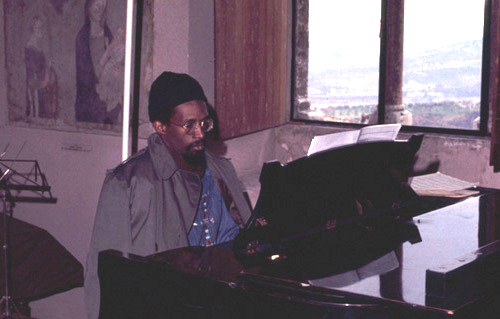I’ve always had a weird fascination – don’t quite understand it myself – with music by famous people who were known for something other than music. I’ve enjoyed a long relationship with the music of Friedrich Nieztsche, own every recording of it ever made (including the old Dietrich Fischer-Dieskau vinyl disc), and savor my Xeroxes of his entire Musikalische Nachlass; I treasure my Wergo recording of the musical works of Theodor Adorno, and enjoy playing for students the hilarious completed bits of his projected opera on Tom Sawyer, Der Schatz des Indianer-Joe; I’ve come to think of Jean Dubuffet almost as much as a pioneer of musique concrète as a painter, though he’s one of my favorite painters as well; and I’ve never given up looking for the music allegedly written by the painter Lionel Feininger (fugues, apparently), though I find Marcel Duchamp’s musical output of little interest. I’ve got this odd idea that someone really brilliant outside the profession might come up with crazily skewed ideas that none of us composers would have thought of. Or else I think that the person’s music might give me an insight into Nietzsche or Adorno that I couldn’t get from their writings.
So I was knocked for a loop by a new Bis CD by pianist Lera Auerbach called Tolstoy’s Waltz. My impression that the title was mere metaphor gave way as I finally deigned to give the thing a closer look, and yes, the author of War and Peace did actually write a waltz, and Ms. Auerbach has recorded it. Not only that, there are two preludes and a sonata here by Boris Pasternak of Doctor Zhivago fame, a song by the impresario Sergei Diaghilev, a waltz by the great choregrapher George Balanchine, plus pieces by other Russians like the painters Pavel Fedotov and Vasily Polenov, the intellectual Vladimir Odoyevsky, and the playwright Alexander Griboyedov. Eight famous Russians, not a professional composer in the bunch, though liner notes by Marina Tiourcheva detail their musical training and accomplishments to an extent that should embarrass us 20th-century-trained Americans for being uncultured fools by comparison. Apparently any educated 19th-century Russian of artistic bent played Beethoven’s sonatas passably well and tried his hand at composition just to see, you know, if he had a knack for it.
Most of them do not, noticeably. The creator of Anna Karenina turned out a nice little waltz with oom-pah-pah in the left hand and some pleasingly sharp appoggiaturas in the right – no more can I say for it. Pasternak, however, was on another level. His mother was a pianist and the family knew Scriabin, which accounts for a strong Scriabin influence on young Pasternak’s preludes, but isn’t sufficient to explain the delicate and arresting textures of his 13-minute, one-movement sonata of 1909. That’s a major work. Polenov had a dark imagination, if no technique beyond the ordinary; but I would have to become enamored of his painting for the music to have any interest. Diaghliev’s song is uninspiredly Wagnerian, with too many tremolos in the piano. Balanchine’s waltz is far more imaginative than Tolstoy’s, with a listless grace that knows how to play off the meter rather than tread on it – one could easily imagine choregraphing the piece, and I think I’ll take a copy to the dance faculty here. But I’m glad to think Tolstoy wrote a waltz, even if I file this disc under Pasternak. And I’m glad that people like Lera Auerbach are taking care of the musical estates of great writers and painters and thinkers, no matter how slim their content.
UPDATE: Joseph L. in the comments reminds me that I forgot about one of the most interesting non-composer composers, Ezra Pound. He considered setting words to music one of the major forms of poetic criticism, and I’ve long been a fan of his Testament of Villon – but Other Minds owes me a copy of their new Pound CD, and I guess I’ll have to bug them for it. Pound was a big early influence on my development, and I even studied Provençal in college with a Pound fanatic. To this day I can quote Arnaut Daniel from memory:
Iu suis Arnaut, q’amas l’aura
E chatz la lebre ab lo bou,
E nadi contra suberna.I am Arnaut, who gathers the wind,
And hunts the hare with the ox,
And swims against the incoming tide.


